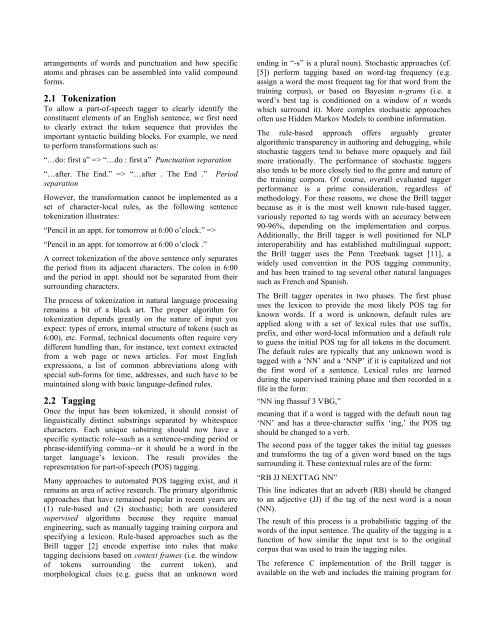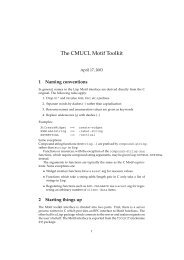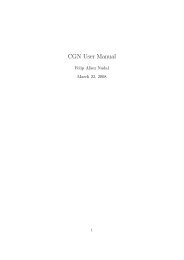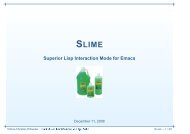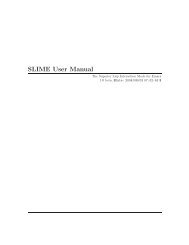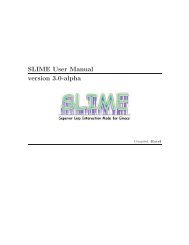Langutils: A Natural Language Toolkit for Common Lisp - Liu, Hugo
Langutils: A Natural Language Toolkit for Common Lisp - Liu, Hugo
Langutils: A Natural Language Toolkit for Common Lisp - Liu, Hugo
Create successful ePaper yourself
Turn your PDF publications into a flip-book with our unique Google optimized e-Paper software.
arrangements of words and punctuation and how specific<br />
atoms and phrases can be assembled into valid compound<br />
<strong>for</strong>ms.<br />
2.1 Tokenization<br />
To allow a part-of-speech tagger to clearly identify the<br />
constituent elements of an English sentence, we first need<br />
to clearly extract the token sequence that provides the<br />
important syntactic building blocks. For example, we need<br />
to per<strong>for</strong>m trans<strong>for</strong>mations such as:<br />
“…do: first a” => “…do : first a” Punctuation separation<br />
“…after. The End.” => “…after . The End .”<br />
separation<br />
Period<br />
However, the trans<strong>for</strong>mation cannot be implemented as a<br />
set of character-local rules, as the following sentence<br />
tokenization illustrates:<br />
“Pencil in an appt. <strong>for</strong> tomorrow at 6:00 o’clock.” =><br />
“Pencil in an appt. <strong>for</strong> tomorrow at 6:00 o’clock .”<br />
A correct tokenization of the above sentence only separates<br />
the period from its adjacent characters. The colon in 6:00<br />
and the period in appt. should not be separated from their<br />
surrounding characters.<br />
The process of tokenization in natural language processing<br />
remains a bit of a black art. The proper algorithm <strong>for</strong><br />
tokenization depends greatly on the nature of input you<br />
expect: types of errors, internal structure of tokens (such as<br />
6:00), etc. Formal, technical documents often require very<br />
different handling than, <strong>for</strong> instance, text context extracted<br />
from a web page or news articles. For most English<br />
expressions, a list of common abbreviations along with<br />
special sub-<strong>for</strong>ms <strong>for</strong> time, addresses, and such have to be<br />
maintained along with basic language-defined rules.<br />
2.2 Tagging<br />
Once the input has been tokenized, it should consist of<br />
linguistically distinct substrings separated by whitespace<br />
characters. Each unique substring should now have a<br />
specific syntactic role--such as a sentence-ending period or<br />
phrase-identifying comma--or it should be a word in the<br />
target language’s lexicon. The result provides the<br />
representation <strong>for</strong> part-of-speech (POS) tagging.<br />
Many approaches to automated POS tagging exist, and it<br />
remains an area of active research. The primary algorithmic<br />
approaches that have remained popular in recent years are<br />
(1) rule-based and (2) stochastic; both are considered<br />
supervised algorithms because they require manual<br />
engineering, such as manually tagging training corpora and<br />
specifying a lexicon. Rule-based approaches such as the<br />
Brill tagger [2] encode expertise into rules that make<br />
tagging decisions based on context frames (i.e. the window<br />
of tokens surrounding the current token), and<br />
morphological clues (e.g. guess that an unknown word<br />
ending in “-s” is a plural noun). Stochastic approaches (cf.<br />
[5]) per<strong>for</strong>m tagging based on word-tag frequency (e.g.<br />
assign a word the most frequent tag <strong>for</strong> that word from the<br />
training corpus), or based on Bayesian n-grams (i.e. a<br />
word’s best tag is conditioned on a window of n words<br />
which surround it). More complex stochastic approaches<br />
often use Hidden Markov Models to combine in<strong>for</strong>mation.<br />
The rule-based approach offers arguably greater<br />
algorithmic transparency in authoring and debugging, while<br />
stochastic taggers tend to behave more opaquely and fail<br />
more irrationally. The per<strong>for</strong>mance of stochastic taggers<br />
also tends to be more closely tied to the genre and nature of<br />
the training corpora. Of course, overall evaluated tagger<br />
per<strong>for</strong>mance is a prime consideration, regardless of<br />
methodology. For these reasons, we chose the Brill tagger<br />
because as it is the most well known rule-based tagger,<br />
variously reported to tag words with an accuracy between<br />
90-96%, depending on the implementation and corpus.<br />
Additionally, the Brill tagger is well positioned <strong>for</strong> NLP<br />
interoperability and has established multilingual support;<br />
the Brill tagger uses the Penn Treebank tagset [11], a<br />
widely used convention in the POS tagging community,<br />
and has been trained to tag several other natural languages<br />
such as French and Spanish.<br />
The Brill tagger operates in two phases. The first phase<br />
uses the lexicon to provide the most likely POS tag <strong>for</strong><br />
known words. If a word is unknown, default rules are<br />
applied along with a set of lexical rules that use suffix,<br />
prefix, and other word-local in<strong>for</strong>mation and a default rule<br />
to guess the initial POS tag <strong>for</strong> all tokens in the document.<br />
The default rules are typically that any unknown word is<br />
tagged with a ‘NN’ and a ‘NNP’ if it is capitalized and not<br />
the first word of a sentence. Lexical rules are learned<br />
during the supervised training phase and then recorded in a<br />
file in the <strong>for</strong>m:<br />
“NN ing fhassuf 3 VBG,”<br />
meaning that if a word is tagged with the default noun tag<br />
‘NN’ and has a three-character suffix ‘ing,’ the POS tag<br />
should be changed to a verb.<br />
The second pass of the tagger takes the initial tag guesses<br />
and trans<strong>for</strong>ms the tag of a given word based on the tags<br />
surrounding it. These contextual rules are of the <strong>for</strong>m:<br />
“RB JJ NEXTTAG NN”<br />
This line indicates that an adverb (RB) should be changed<br />
to an adjective (JJ) if the tag of the next word is a noun<br />
(NN).<br />
The result of this process is a probabilistic tagging of the<br />
words of the input sentence. The quality of the tagging is a<br />
function of how similar the input text is to the original<br />
corpus that was used to train the tagging rules.<br />
The reference C implementation of the Brill tagger is<br />
available on the web and includes the training program <strong>for</strong>


